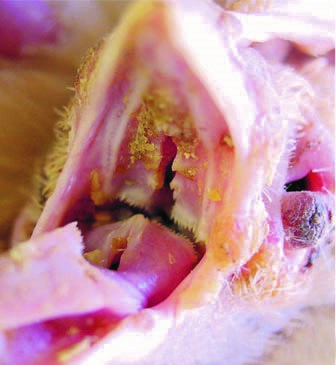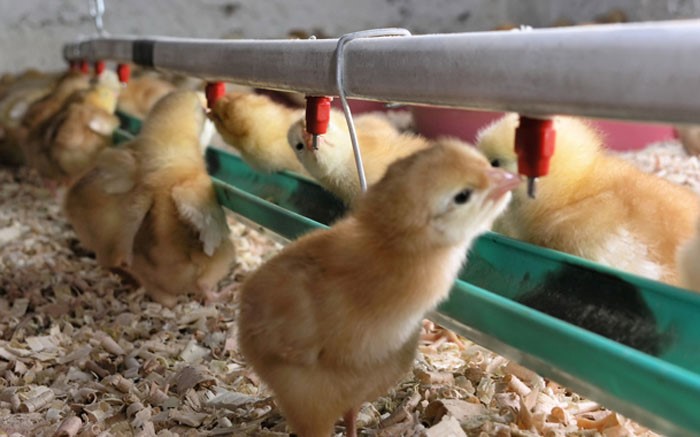Crop and intestinal mycosis in chickens is a dangerous disease that greatly affects poultry health. So, what are its harmful effects on chickens and how can it be effectively prevented and treated?
Currently, the poultry industry is developing at various scales. However, one common issue faced by many farms—yet often overlooked—is the harmful impact of crop and intestinal mycosis. Chickens are highly susceptible to this disease, which significantly reduces their productivity. Therefore, understanding the harmful effects of crop and intestinal mycosis in chickens and applying thorough prevention and treatment measures is crucial to achieving high economic efficiency in poultry farming.
1. DEFINITION
Crop and intestinal mycosis in chickens is a common and dangerous disease that significantly affects poultry health and productivity, even leading to mortality. Many farmers tend to underestimate this disease, resulting in delayed detection and treatment, which causes serious consequences.

2. CAUSES
– Chickens being starved for a long period, leaving the crop empty.
– Poor hygiene of feeding and drinking equipment; contaminated feed and water serve as sources of fungal infection.
– Secondary infection from other gastrointestinal diseases.
– Moldy or spoiled feed.
– Vitamin A deficiency.
– Heat stress during transportation or poor rearing environment.
– Prolonged use of antibiotics in feed or water, creating favorable conditions for fungal overgrowth in the digestive tract.
– Some yeast species are naturally present in the gut, but when immunity decreases, they multiply and cause disease.
3. PATHOGENIC EFFECTS OF CROP AND INTESTINAL MYCOSIS
– Liver damage: Mycotoxins act directly on hepatocytes, causing varying degrees of lesions.
– Kidney swelling: Impaired detoxification, worsening clinical toxicosis.
– Immunosuppression: Reduced antibody response, increased susceptibility to secondary infections, and risk of mortality.

– Gastrointestinal mucosal erosion: Necrosis and sloughing of epithelial cells form pseudomembranes that obstruct feed passage.
– Reproductive disorders: In poultry, high embryonic mortality at early incubation stages and reduced hatchability.
– Reduced feed palatability: Mold growth alters feed odor, mycotoxins decrease appetite, leading to poor growth and feed conversion ratio (FCR).
– Vitamin destruction: Fungal fermentation depletes nutrients, especially vitamins.
– Carcinogenic risk: Mycotoxins in poultry products pose a public health hazard.
– Growth retardation: Poor absorption, feather ruffling, increased FCR, and decreased economic efficiency.
4. PREVENTION
– The primary approach to preventing fungal diseases is to enhance the animal’s immunity. Rearing conditions and feed formulation play a crucial role. In particular, dietary components such as protein, vitamins, and trace minerals are essential in strengthening the mucosal defenses against infection.
– Always maintain a clean farming environment. For brooding chicks, avoid using damp or moldy rice husks; keep housing well-ventilated. Treat bedding materials before use with antifungal agents such as CuSO₄ (1 g/3 liters of water); disinfect by spraying with Dexon Super.
– Ensure clean feed and water; regularly check quality to avoid mold contamination, thereby preventing fungal transmission to chickens via these two main routes.

– Minimize stress factors (overcrowding, overheating, excessive light).
– Use antibiotics rationally. Prophylaxis can be achieved with antifungals containing Nystatin (e.g., Nysneo WS ).
– Cull weak or stunted birds.
– Treat drinking water with Aquapure 1000 , an effervescent tablet effective against bacteria, fungi, spores, viruses, and protozoa.

5. TREATMENT
First, it is necessary to eliminate fungal infection in the chicken’s body, while simultaneously enhancing hepatic and renal detoxification and strengthening the bird’s immunity. The following treatment regimen can be applied:
– Administer antifungal drugs containing Nystatin, such as Nysneo WS, continuously for 4–5 days.
– Provide digestive probiotics (Chocotic) via drinking water or mixed into feed for 7–10 consecutive days to stabilize the gastrointestinal tract.
– Boost immunity and improve overall condition by administering Becom WS continuously for 5–7 days.
– Support acute liver and kidney detoxification by using Intertonic Oral for 5–7 consecutive days.
Understanding the harmful effects of crop and intestinal mycosis and applying proper preventive and therapeutic measures will help poultry farmers maintain flock health, increase productivity, and achieve higher economic efficiency.
